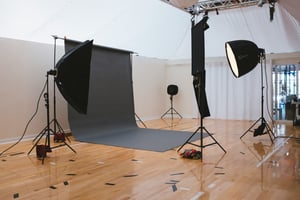In the digital arena, where innovation is relentless, the emergence of AI studios marks a...
It is not an AI studio without design
I had an interesting conversation with a client today on this topic. They were curious about why we have set Friyay.ai up as a generative AI studio and what an AI studio actually is. Their question came from the fact they are seeing a heap of AI studios popping up but not much substance behind what capability these studios have. Given this, I wanted to help provide more detail on what an AI studio is, specifically focusing on the capability it must have to be effective so that you don’t end up with all sizzle and no sausage.
Let’s start with what a design studio is because this is what an AI studio should be built off.
A design studio is a workspace where creative professionals, such as designers, work on various projects involving visual, product, or architectural design. The key components of a design studio include:
1. Space and layout: The physical space is usually open and flexible, allowing designers to rearrange their work areas as needed for different projects. This layout helps foster collaboration and creativity among the team members. NOTE this can be both physical and digital - tools such as MIRO have enabled many design teams to thrive in a remote working context.
2. Tools and equipment: Design studios are equipped with the necessary tools for design work. This might include computers with design software, drawing tables, and areas for prototyping materials like paper, fabrics, or other crafting supplies.
3. Team and collaboration: Design studios often consist of a team that can include graphic designers, product designers, architects, and other specialists. Collaboration is a big part of the environment, with team members sharing ideas and feedback. NOTE how many time the word ‘designers’ is used.
4. Projects and clients: The work done in a design studio varies widely depending on the focus of the studio. It could range from creating visual advertisements, designing websites, developing new products, or planning buildings. Studios often work for clients who commission these projects, requiring designers to meet specific needs or solve particular problems.
5. Creativity and innovation: A central aspect of a design studio's environment is creativity. The space and culture are designed to inspire designers to think innovatively and come up with creative solutions to design challenges. NOTE this is one of the things I love the most about working in these environments.
Ultimately design studios serve as a hub for creativity, where the design process from concept to completion is carried out collaboratively and creatively. Reading the above you can see why this can so effectively apply to AI BUT it is not as simple as replacing ‘Design’ with ‘AI’.
For a business without a deep understanding of what a design studio is and what capabilities are required branding themselves as an AI studio is is extremely risky and can lead to poor outcomes for the clients that engage their services in the AI space.
Now that we have that bit of context out of the way, back to the conversation with my client. To keep it simple I explained to them what capabilities need to exist in a proper AI studio, with these being (note these capabilities can exist in one or many people depending on the size of the studio).
Essential capabilities for an AI studio
A well-rounded AI studio should have a comprehensive set of skills and capabilities that include:
1. AI Developer: This consolidated capability encompasses AI development and research, data science, and software engineering. o AI Development and Research: Proficiency in creating and refining AI models to suit specific applications, utilising the latest in machine learning and neural networks. o Data Science: Skills in managing data through its entire lifecycle — collection, cleaning, analysis — to ensure that AI systems are trained on high-quality, relevant data for accurate and effective outputs. o Software Engineering: Ability to develop robust software that integrates AI smoothly into applications or business processes, with an emphasis on scalability and security.
2. Project Management: Expertise in orchestrating projects efficiently to keep AI integration initiatives on track in terms of schedule, budget, and targeted objectives.
3. User Experience (UX) Design: Essential skills in crafting interfaces and interactions that make AI tools accessible and beneficial for end-users, ensuring the technology is user-friendly. Selfishly as a service designer I kept out this capability in my first explanation to see if my client called this out. Nothing gets passed them and they asked why I am there.
Below is why I feel service design is also essential in an AI studio.
If a generative AI studio lacks service design capabilities, it can still function effectively but may miss out on crucial elements that significantly enhance the user experience and customer satisfaction.
Service design is vital for several reasons:
• Holistic user experience: Service design considers the entire user experience, ensuring each touchpoint within a service is thoughtfully designed to meet user needs effectively and pleasantly. Without this, AI solutions might not align well with user expectations or the business context, potentially leading to reduced adoption rates.
• Integration into business processes: Service design ensures new technologies are smoothly integrated into existing business processes, making AI solutions practical and beneficial from an operational standpoint.
• Customer-centric solutions: Focusing on customer journeys and experiences, service design ensures that AI applications are truly customer-centric, which enhances customer satisfaction and loyalty.
Lacking service design means an AI studio might produce solutions that are technologically sound but fail to resonate with users or integrate smoothly into business workflows. Including service designers (like me!) significantly enhances the effectiveness and impact of AI solutions, making them more sustainable and successful in real-world applications.
If you are keen to get started with integrating generative AI into your business and want to engage with an AI studio, ask them to breakdown the capabilities they have access to in their studio. If it is missing design it is more likely just a name and not a workspace.
Gareth Rydon is a co-founder and service designer at Friyay.ai studio, where his work centres around embedding human-centred design principles into generative AI. Discover more at www.friyay.ai




